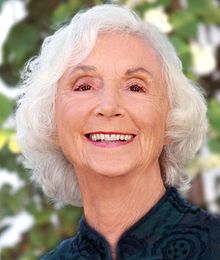Barbara Marx Hubbard
A Profile Of Barbara Marx Hubbard: 
“If I did not know life’s larger purpose, how could I know my own purpose?”
Many Americans remember 1984 as the year Geraldine Ferraro became the first woman to run for Vice-President. They may not realize that another woman, Barbara Marx Hubbard, was also a vice-presidential candidate.
Now 76, this public speaker, author and social innovator laughs as she recalls speaking at the Democratic National Convention. “As the guard escorted me to the platform he said: “Honey, they won’t pay attention to you; you’ll be saying this to the universe.” Little did he know that Hubbard was a deeply spiritual person whose life work involved communicating her vision to an audience that extended far beyond the walls of any convention hall.
“When he mentioned the universe, my feeling was one of mystical reality. His comment helped me overcome my sense of doubt and sense of disappointment that no one was really paying attention. It also let me focus on the notion that thought creates.”
One such thought was the creation of an office of the future and a ‘Peace Room.’ The goal was to match the sophistication of the Pentagon’s war room, not only in Washington D.C. but in every other world capital. But instead of tracking our enemies’ movements and working to defeat them, the Peace Room would track successful projects, initiatives and individuals from every sector of society.
This idea had been welling up inside Hubbard ever since the US dropped the atomic bombs on Japan. Though she was only fifteen, the event caused Hubbard to turn to deep philosophical questions. “What is the meaning of our new technological powers? What is the purpose of Western civilization?” she wondered. To find the answers, she immersed herself in the work of Greek and Roman philosophers. She also read the existentialists like Sartre and Camus as well as the materialists who viewed the universe as nothing but matter. Unsatisfied by what she found, Hubbard became a ‘metaphysical seeker.’ “If I did not know life’s larger purpose, how could I know my own purpose?”, she said.
As a Bryn Mawr student doing her junior year in Paris, Hubbard finally heard an answer that satisfied her. Sitting in a cafe on a cold November day, she began talking with a young man. As Earl Hubbard took a drag on his cigarette he said: “I am an artist. My purpose is to seek a new image of humanity commensurate with our power to shape the future.” She ultimately married him.
But being married, even to someone with the answers was not enough. Hubbard began reading the Christian mystic, Teilhard de Chardin, who wrote about a new kind of human on the earth who was attracted to the future. However, later, as a mother of five, living in Lakeville, Connecticut Hubbard’s interest in the future made her look neurotic. Said the local psychiatrist. “There’s something wrong with you Barbara, because you think you need to connect and you’ve got more to do. You’re 32 years old, you’ve got 5 kids and a great husband, how could you be thinking this? You’re sublimating; your libido is off,” he told her.
The Evolutionary Crossroads
Suburban Connecticut in the 1950’s wasn’t exactly the place to dialogue about humanity’s path. Most of Hubbard’s contemporaries at the time were trying to escape from such ideas. She soon felt like “the ugly duckling in the swamp,” and was compelled to find others who were also drawn to emerging paradigms.
Then Hubbard met Jonas Salk and told him about her unconventional ideas and how everything was wrong with her. He told her “This isn’t what’s wrong about you, it’s what’s right about you. You are a mutant.” Salk wasn’t being funny; he was referring to his belief that, unlike most people on the planet, Hubbard embodied the characteristics needed by evolution to help bring humanity to the next level. He introduced her to three men: Al Rosenfeld, science editor for Life magazine, Dr. Joel Elkes, director of the department of psychopharmacology at Johns Hopkins and Louis Kahn, the architect who was working on the Salk Institute. Hubbard was finally able to connect with other ‘evolutionary souls’. More than that, she had found the path to her life work.
In 1968-69 Hubbard published “The Center Letter”, one of the first newsletters on evolutionary transformation. She was also one of the original contributors to the Salk Institute. The following year, in Washington, D.C., she founded the Committee for the Future, which used her work to develop the New Worlds Educational and Training Center.
After her brush with politics in 1984, Hubbard went on to co-found the Foundation for Conscious Evolution with Sidney Lanier in 1992. As she points out in her book of that title, “Conscious evolution is a worldview that looks at the natural process of evolution in the past, and attempts to understand and guide our own period of transformation now. It acknowledges that humankind has attained unprecedented powers to control and change the evolution of life on Earth.”
Indeed, Hubbard believes that the human family has come to an evolutionary crossroads. “It’s obvious that if we continue doing what we’ve been doing, including overpopulating, polluting, fighting with this degree of violence that we are heading to a point where we could actually destroy our own life support systems,” she says.
Words that chillingly resonate as the world recently watched the war in Iraq. Still, Hubbard remains optimistic. “A consciousness is rising on earth against war. And no matter what, the consciousness won’t stop. I think we will see an increased uprising against the militaristic attitude and a real need to mobilize and organize for a better way. In any case, we’re going to be challenged to take greater leadership, not just to protest but to join together to build a world.”
In reflecting on the many challenges we face, she notes, “We’re now seeing the tail end of egoic based dominator structures, which happen to be in power in the most powerful nation in the world.” Not that she looks to political activists for solutions. “Sure, there was a time when you might have thought that one party or the other was the answer, but now I think something of a far more transformative nature is wanting to happen. The dysfunctionality in our current power structures will be revealed resulting in the emergence of a new politics of synergy, attraction and creation. It will be irresistible because it’s actually life-oriented, but it can’t happen,” she says, “until that which is new-functional matures and connects.”
Hubbard is now helping to create a new social system to connect the growing movement of individuals working toward a sustainable future. In fact, nearly two decades after she “spoke to the Universe” in San Francisco, her Peace Room initiative is coming to life, through her Gateway for Conscious Evolution, a six-month online educational program that guides individuals through self- and social evolution.
Visitors to her web site www.consciousevolution.net will see the idea graphically represented in the form of an ‘operating hub’ divided into 12 major areas. Categories like Communications & Media, Science & Technology, Environment & Infrastructure and Learning & Education are just some of the initiatives.
The Peace Room, “means peace through co-creation, through the full expression of human creativity in cooperation with nature, with one another, and with the deeper design of evolution.”
Though it currently exists on the Internet it will eventually have a physical presence in locations around the world. And sometime within this decade, Hubbard envisions the first Global Peace Room hosted by the United Nations. Says Hubbard, “we will move beyond our current confusion and see that the purpose of our crisis is to activate our newly emerging capacities...to restore the earth, free ourselves from illness, hunger and war and build a future equal to our vast potential.”
This year Hubbard will host a live Internet radio program through her web site. “Live from the Peace Room” will feature a “dynamic scanning for the breakthroughs and innovations and showing them as a continuous process for the emerging world.
Hubbard is the author of five books, including her recently published Emergence: The Shift from Ego to Essence, which offers a ten-step process to help individuals climb the evolutionary ladder to become “universal humans”, a state that will allow us to actively participate in the process of creation.
No doubt, Hubbard is on a mission to stretch our species beyond its self-imposed borders. Yet what distinguishes her from others concerned about our future is that she is not only striving for changes within our institutions; she’s also working to help individuals find the power to surpass themselves. Hubbard believes that if we are to address our many challenges, we must first move beyond our egoic existence.
Barbara Marx Hubbard has generously donated her lifelong collection of journals, dating back to 1946, to ISHAR as an open-access cultural artifact. The process of scanning and digitally remastering these hundreds of journals is time-intensive, so this collection will continue to grow each week as more journals are processed, and more delicate manuscripts will take longer to process. Where synopses, tagging, and bibliographic notations have been completed the journal will be marked with an (*). We encourage visitors to review and read these historical documents that track the development of an extraordinary woman.
These journals are by nature subjective and do not fit within ISHAR's scholarly standards or framework, but their historical and cultural importance is tremendous.
- Volume 2
- Volume 3
- Volume 4*
- Volume 6
- Volume 7
- Volume 8
- Volume 9
- Volume 10
- Volume 11
- Volume 12
- Volume 13
- Volume 15
- Volume 16
- Volume 17
- Volume 18
- Volume 19
- Volume 20
- Volume 148
- Volume 149
Bibliography
- The Hunger of Eve: One Woman's Odyssey Toward the Future. Island Pacific Northwest, 1989. ISBN 0-942133-00-5
- The Evolutionary Journey: A Personal Guide to a Positive Future (with Barry Weins and Wabun Wind.) Evolutionary Press, 1993. ISBN 0-943408-01-6
- The Revelation: Our Crisis is a Birth (The Book of Co-Creation). Foundation for Conscious Evolution, 1993. ISBN 0-9631032-0-2
- The Revelation: A Message of Hope for the New Millennium. Nataraj Publishing, 1995 (2nd ed.) ISBN 1-882591-21-6
- Excerpts reprinted by permission of Hay House in the Monthly Aspectarian, available online: Part I, August 1996 and Part II, September 1996
- Conscious Evolution: Awakening the Power of Our Social Potential. New World Library, 1998. ISBN 1-57731-016-0
- Emergence: The Shift from Ego to Essence. Hampton Roads Publishing Company, 2001. ISBN 1-57174-204-2
- Birth 2012 & Beyond: Humanity's Great Shift to the Age of Conscious Evolution. Shift Books, 2012. ISBN 978-0984840700
- Conscious Evolution: Awakening the Power of Our Social Potential. Revised Edition. New World Library, 2015. ISBN 978-1-60868-117-4

